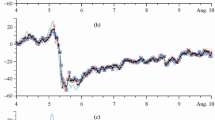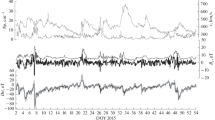Abstract
The possible use of artificial neural networks—classical multilayer perceptrons—with coupling functions to forecast time series of the Dst geomagnetic index is studied. The basic forecast is based on parameters of the solar wind and interplanetary magnetic field measured at the libration point L1 in an experiment on the ACE spacecraft. It is shown that the largest contribution to the improvement in forecast quality is made by the Bs and vBs functions, as well as the use of several coupling functions simultaneously.





Similar content being viewed by others
REFERENCES
Akasofu, S.-I. and Chapman, S., Solar-Terrestrial Physics, Oxford: Clarendon, 1972.
Amata, E., Pallocchia, G., Consolini, G., Marcucci, M.F., and Bertello, I., Comparison between three algorithms for Dst predictions over the 2003–2005 period, J. Atmos. Sol-Terr. Phys., 2008, vol. 70, pp. 496–502.
Barkhatov, N.A., Bellustin, N.S., Levitin, A.E., and Sakharov, S.Y., Comparison of efficiency of artificial neural networks for forecasting the geomagnetic activity index Dst, Radiophys. Quantum Electron., 2000, vol. 43, no. 5, pp. 347–355.
Belov, A.V., Villoresi, J., Dorman, L.I., Eroshenko, E.A., Levitin, A.E., Parisi, M., Ptitsyna, N.G., Tyasto, M.I., Chizhenkov, V.A., Jucci, N., and Yanke, V.G., Effect of the space on operation of satellites, Geomagn. Aeron. (Engl. Transl.), 2004, vol. 44, no. 4, pp. 461–468.
Bishop, C.M., Neural Networks for Pattern Recognition, Oxford: Clarendon, 1996.
Bothmer, V. and Daglis, I.A., Space Weather: Physics and Effects, Berlin: Springer, 2007. https://doi.org/10.1007/978-3-540-34578-7.
Burton, R.K., McPherron, R.L., and Russel, C.T., An empirical relationship between interplanetary conditions and Dst, J. Geophys. Res., 1975, vol. 80, pp. 4204–4214.
Cole, D.G., Space weather: Its effects and predictability, Space Sci. Rev., 2003, vol. 107, pp. 295–302.
Dolenko, S.A., Orlov, Yu.V., Persiantsev, I.G., and Shugai, Ju.S., Neural network algorithm for events forecasting and its application to space physics data, Lect. Notes Comput. Sci., 2005, vol. 3697, pp. 527–532.
Efitorov, A.O., Burikov, S.A., Dolenko, T.A., et al., Comparison of the quality of solving the inverse problems of spectroscopy of multi-component solutions with neural network methods and with the method of projection to latent structures, Opt. Mem. Neural Networks (Inf. Opt.), 2015, vol. 24, no. 2, pp. 93–101.
Efitorov, A.O., Myagkova, I.N., Shirokii, V.R., and Dolenko, S.A., The prediction of the Dst-index based on machine learning methods, Cosmic Res., 2018, vol. 56, no. 6, pp. 434–441.
Farmer, J.D. and Sidorowich, J.J., Predicting chaotic time series, Phys. Rev. Lett., 1987, vol. 59, no. 8, pp. 845–848.
Feldstein, Y.I., Dremukhina, L.A., Levitin, A.E., Mall, U., Alexeev, I.I., and Kalegaev, V.V., Energetics of the magnetosphere during the magnetic storm, Sol-Terr. Phys., 2003, vol. 65, no. 4, pp. 429–446.
Gorban’, A.N., Obuchenie neironnykh setei (Training Neural Networks), Moscow: ParaGraf, 1990.
Kan, J.R. and Lee, L.C., Energy coupling and the solar wind dynamo, Geophys. Res. Lett., 1979, vol. 6, pp. 577–580.
Kataoka, R. and Miyoshi, Y., Average profiles of the solar wind and outer radiation belt during the extreme flux enhancement of relativistic electrons at geosynchronous orbit, Ann. Geophys., 2008, vol. 26, pp. 1335–1339.
Khaikin, S., Neironnye seti: polnyi kurs (A Complete Course of Neural Networks), Moscow: Vil’yams, 2006.
Lazutin, L.L., Mirovye i polyarnye magnitnye buri (World and Polar Magnetic Storms), Moscow: MGU, 2012.
Lindsay, G.M., Russell, C.T., and Luhmann, J.G., Predictability of Dst index based upon solar wind conditions monitored inside 1 AU, J. Geophys. Res., 1999, vol. 104, no. A5, pp. 10335–10344.
Machine Learning Techniques for Space Weather, Camporeale, E., Wing, S., and Johnson, J.R., Eds., Elsevier, 2018. https://doi.org/10.1016/C2016-0-01976-9.
Myagkova, I.N., Shugai, Yu.S., Veselovskii, I.S., and Yakovchuk, O.S., Comparative analysis of recurrent high-speed solar wind streams influence on the radiation environment of near-earth space in April–July 20101, Sol. Syst. Res., 2013, vol. 47, no. 2, pp. 127–140.
Myagkova, I.N., Dolenko, S.A., Efitorov, A.O., et al., Prediction of relativistic electron flux in the Earth’s outer radiation belt at geostationary orbit by adaptive methods, Geomagn. Aeron. (Engl. Transl.), 2017a, vol. 57, no. 1, pp. 8–15.
Myagkova, I., Shiroky, V., and Dolenko, S., Prediction of geomagnetic indexes with the help of artificial neural networks, in E3S Web of Conferences, 2017b, 20:art.02011. https://doi.org/10.1051/e3sconf/20172002011.
Newell, P.T., Sotirelis, T., Liou, K., Meng, C.-I., and Rich, F.J., A nearly universal solar wind–magnetosphere coupling function inferred from 10 magnetospheric state variables, J. Geophys. Res., 2007, vol. 112, A01206. https://doi.org/10.1029/2006JA012015
Pallochia, G., Amata, E., Consolini, G., Marcucci, M.F., and Bertello, I., Geomagnetic Dst index forecast based on IMF data only, Ann. Geophys., 2006, vol. 24, pp. 989–999.
Patra, S., Spencer, E., Horton, W., and Sojka, J., Study of Dst/ring current recovery times using the WINDMI model, J. Geophys. Res., 2011, vol. 116, A02212. https://doi.org/10.1029/2010JA015824
Podladchikova, T.V. and Petrukovich, A.A., Extended geomagnetic storm forecast ahead of available solar wind measurements, Space Weather, 2012, vol. 10, id S07001. https://doi.org/10.1029/2012SW000786.
Revallo, M., Valach, F., Hejda, P., and Bochniceket, J., Modeling of CME and CIR driven geomagnetic storms by means of artificial neural networks, Contrib. Geophys. Geod., 2015, vol. 45, no. 1, pp. 53–65.
Schrijver, C.J., Kauristie, K., Aylward, A.D., et al., Understanding space weather to shield society: A global road map 772 for 2015–2025 commissioned by COSPAR and ILWS, Adv. Space Res., 2015, vol. 55, pp. 2745–2807.
Stepanova, M.V. and Perez, P., Autoprediction of Dst index using neural network techniques and relationship to the auroral geomagnetic indices, Geofis. Int., 2000, vol. 39, no. 1, pp. 143–146.
Sugiura, M., Hourly values of equatorial Dst for the IGY, Ann. Int. Geophys. Year, 1964, vol. 35, pp. 9–45.
Temerin, M. and Li, X., Dst model for 1995–2002, J. Geophys. Res., 2006, vol. 111, A04221. https://doi.org/10.1029/2005JA011257
Vasyliunas, V.M., Kan, J.R., Siscoe, G.L., and Akasofu, S.-I., Scaling relations governing magnetospheric energy transfer, Planet. Space Sci., 1982, vol. 30, pp. 359–365.
Wu, J.-G. and Lundstedt, H., Geomagnetic storm predictions from solar wind data with the use of dynamic neural networks, J. Geophys. Res., 1997, vol. 102, no. A7, pp. 14255–14268.
Yermolaev, Yu.I. and Yermolaev, M.Yu., Solar and interplanetary sources of geomagnetic storms: Space weather aspects, Geofiz. Protsessy Biosfera, 2009, vol. 8, no. 1, pp. 5–35.
Zorich, V.A., Multidimensional Geometry, functions of very many variables, and probability, Theory Probab. Its Appl. (Engl. Transl.), 2015, vol. 59, no. 3, pp. 481–493.
Funding
The study was supported by the Russian Science Foundation, project no. 16-17-00098-P.
Author information
Authors and Affiliations
Corresponding author
Additional information
Translated by A. Nikol’skii
Rights and permissions
About this article
Cite this article
Myagkova, I.N., Shirokii, V.R., Kalegaev, V.V. et al. The Use of Coupling Functions in the Forecasting of the Dst-Index Amplitude with Adaptive Methods. Geomagn. Aeron. 61, 138–147 (2021). https://doi.org/10.1134/S0016793220060092
Received:
Revised:
Accepted:
Published:
Issue Date:
DOI: https://doi.org/10.1134/S0016793220060092




